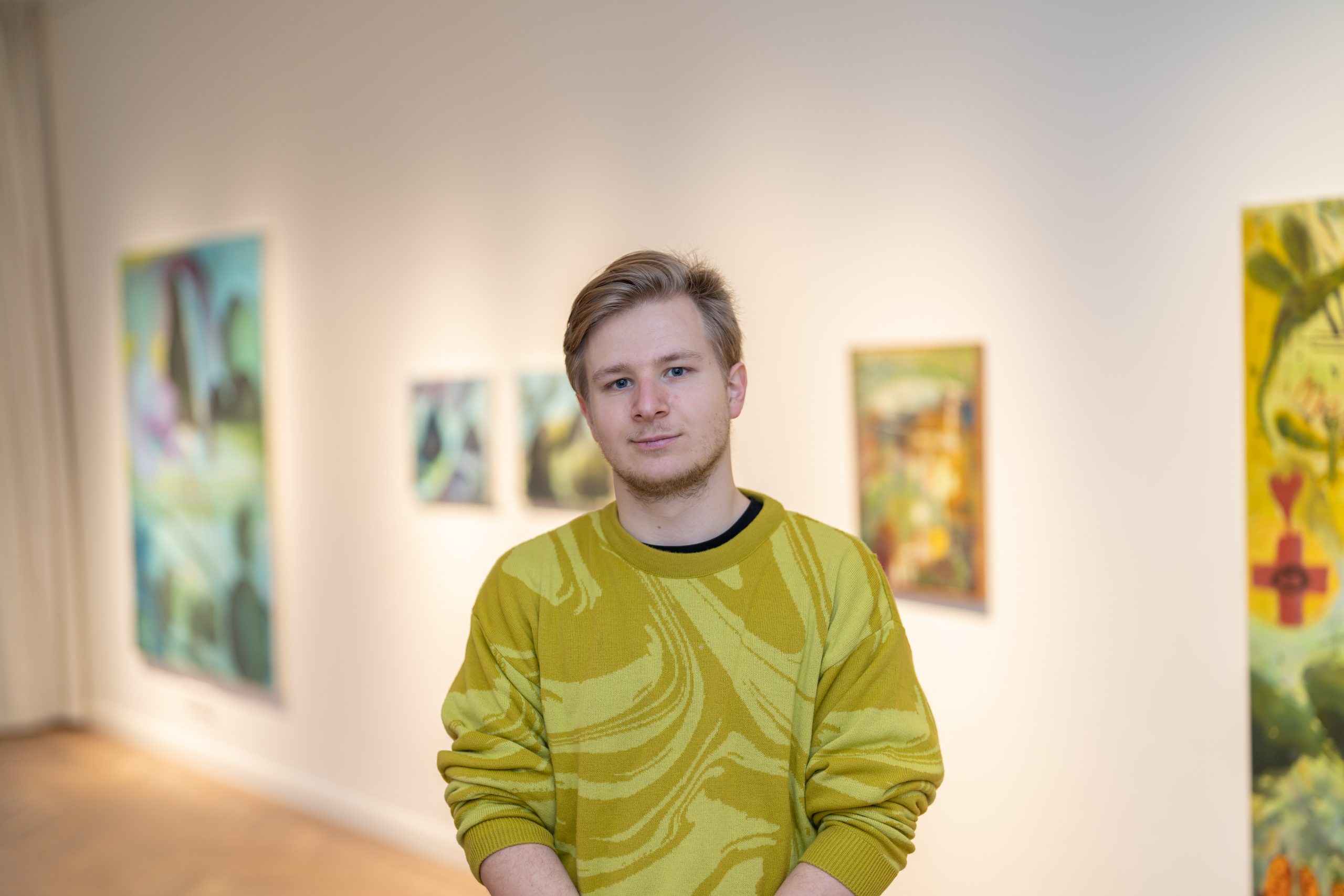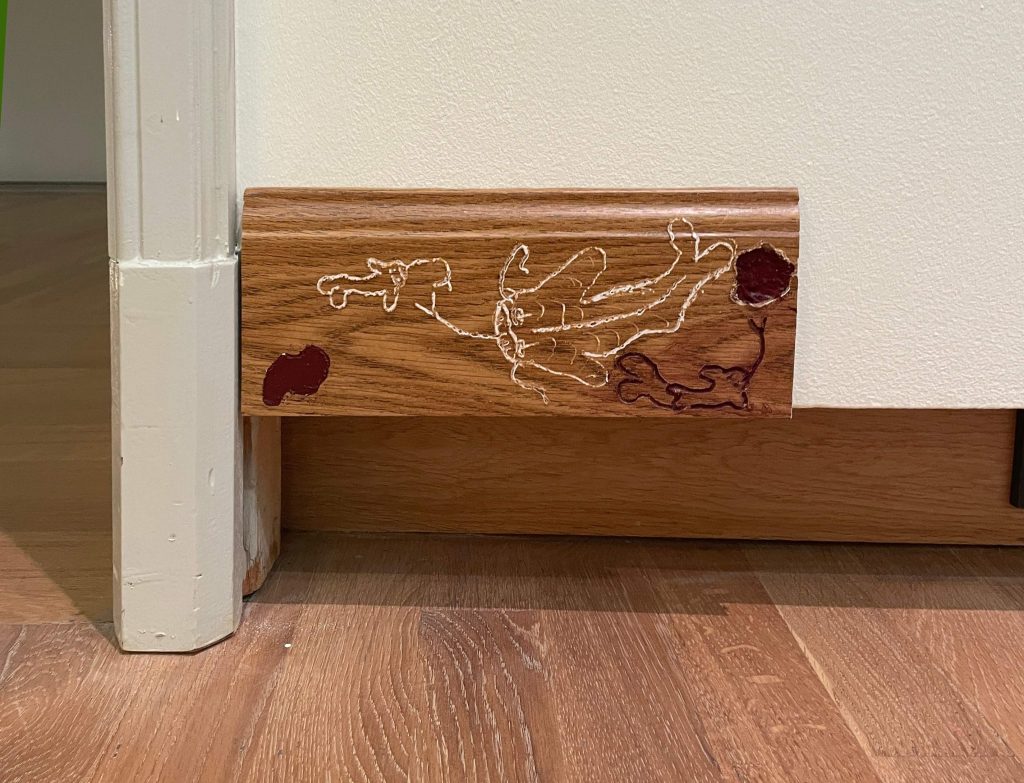Chaos hidden behind cheerful scenes
Sam Hersbach about the importance of meeting rooms and skirting-boards for his practice

"There is increasingly more reality in my paintings," says Sam Hersbach, the painter who gained recognition for works of art featuring dragons and aliens. His presentation at Prospects is based on the meeting room of the Mondriaan Fund. The Distribution Hall where Prospects takes place also appears in one of his works. These two spaces are significant for his artistic practice. As can be expected from Hersbach, he manipulates these spaces and shadows and plants take over the canvases. Hersbach also adds a plinth beneath his work, which he believes adds an extra layer of information and imagination to the overall piece.
Congratulations on your presentation at Prospects. What can we expect?
Thank you very much! For Prospects, I am showcasing a series of paintings and an engraved plinth. I have copied the meeting room of the Mondriaan Fund and also done a painting of the Prospects exhibition space at the Van Nelle factory, which is depicted using a digital three-dimensional sketch from the architectural firm before the space was finished. I have also made a painting combining these spaces with imaginative creatures, realistic self-portraits, varying scales – sometimes on a scale of 1 cm, other times 10 kilometres – images I've photographed of a wild sea and drawings of drones, periscopes, mosquitoes and other animals. I used homemade pigments, such as dried flowers from my studio building's garden, weeds from my street or plants that form a connection with the painted space. There is also a plinth engraved with drawings and texts beneath the work to integrate it more into the space itself, an extra layer for communication, representation and imagination as it were.
Why did you decide to paint a meeting room?
Normally, my work starts with a concept and develops through different layers of fantasy and reality: drones, submarines, deep-sea creatures, lost people amidst alien-like mega butterflies, and so on. With the series of meeting rooms, the starting point is an existing space, one that is important for my artistry and exhibitions. My studio space, exhibition spaces – each has its own story. These spaces transform: beings walk through them and shadows and plants take over the canvas. They reference influential environments, either for me or art in general. The meeting room has been essential in my process towards exhibiting at Prospects and is essential for my participation in the exhibition. This is also the last time Prospects will be held at the Van Nelle factory, so it's a space that has served as a stage for many people.

You now also create work on plinths. Painters typically want to make larger canvases, but this is an unassuming surface. How did you come up with this idea?
The plinths originated from the murals I created a few times. I was asked to explore new supports to tell stories. A mural is already more connected to architecture than a conventional painting because it blends into the space. A plinth is a natural progression. On a plinth, you can write source references, show sketches or engrave titles. Compared to a conventional painting, a plinth is a much less dominant support. It's also a way to add an extra layer of information and ‘fantasy’ to the whole.
A recurring theme in your work is power imbalances and human hubris in technological developments. Does that still play a role in your most recent work?
My work has evolved over the years and explored multiple themes. Technological developments, like the Dutch-acquired Reaper Q9 drones for submarines and genetically modified mosquitoes, appear in my works. The paint itself plays a crucial role. The emotion in the paint and brushstroke, the play of light with colour and the chosen pigments engage in a dialogue with the underlying narratives. Between the plinth and conventional painting, there is also a power dynamic of information delivery and tradition in art. The tradition of an isolated canvas in a space, the white cube idea of art, stands in contrast to an element that blends more into the space.
I’m also wondering whether the emphasis on power dynamics conceals a broader story you wish to tell?
The work has layers of fantasy and layers of reality, from conventional fantasy figures to figures inspired by reality. In each exhibition, the works vary, from mountain landscapes that don't exist to work that relates to the exhibition space or award. To give an example, for the Ary Scheffer Prize (together with Afra Eisma and Niek Hendrix) at the Dordrechts Museum, I created work about Ary Scheffer's mother, Cornelia Scheffer-Lamme. She was a fantastic artist, but unfortunately is much less famous than her son. I had the honour and good fortune to create work about her and her son in tribute to Cornelia Scheffer-Lamme's work and motherhood/parenthood in general. I also had the opportunity to select work from the depot and hang it next to mine to curate an exhibition.
What also characterises your work is a certain relativising humour. Why is that? My work is like a comedy, serious yet humorous. It is chaos hidden behind cheerful scenes, pleasant colours with anxious figures. There must be balance in the works, which should be simultaneously accessible yet repulsive.
I think your visual language has become more concrete and ‘everyday’ in recent years. Previously, a dragon might appear in your work, but the canvases I saw this summer including such things as Andre Hazes and a FaceTime conversation. Do you agree with this observation and is there a reason that you now paint more everyday subjects?
There is increasingly more reality in my paintings, ranging from self-portraits and historical figures to photos of my studio and other real-life inspirational elements. Andre Hazes was originally created for an exhibition honouring a transporter who was a huge Hazes fan. I painted Hazes, who is half mountain and directs his microphone towards the universe, as if he wants to record space sounds – sounds from the vast universe, far away from our small planet.
Last year, you received a grant from the Mondriaan Fund. Is there a project you were able to carry out through the grant that you wouldn't have been able to do otherwise?
As an artist, I always have the drive to create work with the means I have, but the Start grant from the Mondriaan Fund gave me the freedom to work on projects. It helped with purchasing materials, connecting with other artists through the events they organise and with visibility at the Prospects exhibition. Additionally, writing a grant application helps you focus on your work in a different way, attempting to establish its essence. This grant helped me tremendously and has been essential in my research and development.
You're now 28 and already have the Royal Award for Free Painting, have completed the Ateliers and received a grant from the Mondriaan Fund. What are your plans for the next five years?
I am focusing on further improving the content of my work with even more homemade pigments and other materials. I am also aiming for internationalisation, applying for residencies and to participate in exhibitions in other countries. What I learned at the Ateliers is that you can learn so much from people from around the world. It was fantastic to meet not only different tutors, but also fellow participants. Every art world is different, just like every history and discourse. That's why I want to showcase my work in different contexts and let it grow by learning from different people and locations.
Written by Wouter van den Eijkel


